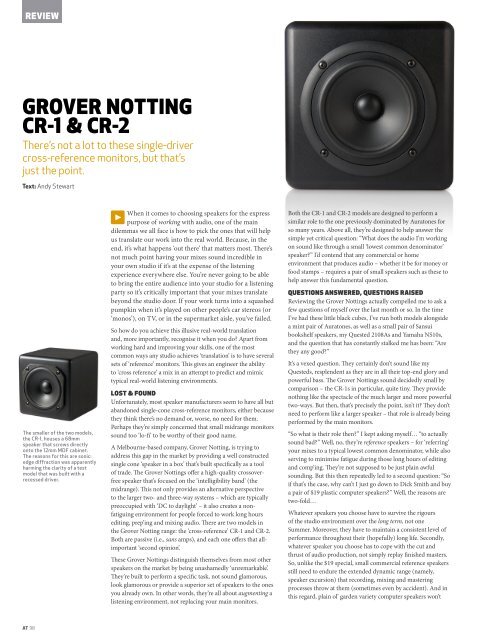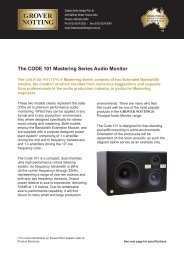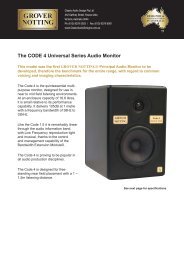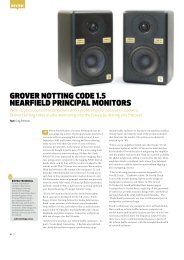Create successful ePaper yourself
Turn your PDF publications into a flip-book with our unique Google optimized e-Paper software.
REVIEW<br />
<strong>GROVER</strong> <strong>NOTTING</strong><br />
<strong>CR</strong>-1 & <strong>CR</strong>-2<br />
There’s not a lot to these single-driver<br />
cross-reference monitors, but that’s<br />
just the point.<br />
Text: Andy Stewart<br />
The smaller of the two models,<br />
the <strong>CR</strong>-1, houses a 68mm<br />
speaker that screws directly<br />
onto the 12mm MDF cabinet.<br />
The reasons for this are sonic:<br />
edge diffraction was apparently<br />
harming the clarity of a test<br />
model that was built with a<br />
recessed driver.<br />
AT 98<br />
When it comes to choosing speakers for the express<br />
purpose of working with audio, one of the main<br />
dilemmas we all face is how to pick the ones that will help<br />
us translate our work into the real world. Because, in the<br />
end, it’s what happens ‘out there’ that matters most. There’s<br />
not much point having your mixes sound incredible in<br />
your own studio if it’s at the expense of the listening<br />
experience everywhere else. You’re never going to be able<br />
to bring the entire audience into your studio for a listening<br />
party so it’s critically important that your mixes translate<br />
beyond the studio door. If your work turns into a squashed<br />
pumpkin when it’s played on other people’s car stereos (or<br />
‘monos’), on TV, or in the supermarket aisle, you’ve failed.<br />
So how do you achieve this illusive real-world translation<br />
and, more importantly, recognise it when you do? Apart from<br />
working hard and improving your skills, one of the most<br />
common ways any studio achieves ‘translation’ is to have several<br />
sets of ‘reference’ monitors. This gives an engineer the ability<br />
to ‘cross reference’ a mix in an attempt to predict and mimic<br />
typical real-world listening environments.<br />
LOST & FOUND<br />
Unfortunately, most speaker manufacturers seem to have all but<br />
abandoned single-cone cross-reference monitors, either because<br />
they think there’s no demand or, worse, no need for them.<br />
Perhaps they’re simply concerned that small midrange monitors<br />
sound too ‘lo-fi’ to be worthy of their good name.<br />
A Melbourne-based company, Grover Notting, is trying to<br />
address this gap in the market by providing a well constructed<br />
single cone ‘speaker in a box’ that’s built specifically as a tool<br />
of trade. The Grover Nottings offer a high-quality crossoverfree<br />
speaker that’s focused on the ‘intelligibility band’ (the<br />
midrange). This not only provides an alternative perspective<br />
to the larger two- and three-way systems – which are typically<br />
preoccupied with ‘DC to daylight’ – it also creates a nonfatiguing<br />
environment for people forced to work long hours<br />
editing, prep’ing and mixing audio. There are two models in<br />
the Grover Notting range: the ‘cross-reference’ <strong>CR</strong>-1 and <strong>CR</strong>-2.<br />
Both are passive (i.e., sans amps), and each one offers that allimportant<br />
‘second opinion’.<br />
These Grover Nottings distinguish themselves from most other<br />
speakers on the market by being unashamedly ‘unremarkable’.<br />
They’re built to perform a specific task, not sound glamorous,<br />
look glamorous or provide a superior set of speakers to the ones<br />
you already own. In other words, they’re all about augmenting a<br />
listening environment, not replacing your main monitors.<br />
Both the <strong>CR</strong>-1 and <strong>CR</strong>-2 models are designed to perform a<br />
similar role to the one previously dominated by Auratones for<br />
so many years. Above all, they’re designed to help answer the<br />
simple yet critical question: “What does the audio I’m working<br />
on sound like through a small ‘lowest common denominator’<br />
speaker?” I’d contend that any commercial or home<br />
environment that produces audio – whether it be for money or<br />
food stamps – requires a pair of small speakers such as these to<br />
help answer this fundamental question.<br />
QUESTIONS ANSWERED, QUESTIONS RAISED<br />
Reviewing the Grover Nottings actually compelled me to ask a<br />
few questions of myself over the last month or so. In the time<br />
I’ve had these little black cubes, I’ve run both models alongside<br />
a mint pair of Auratones, as well as a small pair of Sansui<br />
bookshelf speakers, my Quested 2108As and Yamaha NS10s,<br />
and the question that has constantly stalked me has been: “Are<br />
they any good?”<br />
It’s a vexed question. They certainly don’t sound like my<br />
Questeds, resplendent as they are in all their top-end glory and<br />
powerful bass. The Grover Nottings sound decidedly small by<br />
comparison – the <strong>CR</strong>-1s in particular, quite tiny. They provide<br />
nothing like the spectacle of the much larger and more powerful<br />
two-ways. But then, that’s precisely the point, isn’t it? They don’t<br />
need to perform like a larger speaker – that role is already being<br />
performed by the main monitors.<br />
“So what is their role then?” I kept asking myself… “to actually<br />
sound bad?” Well, no, they’re reference speakers – for ‘referring’<br />
your mixes to a typical lowest common denominator, while also<br />
serving to minimise fatigue during those long hours of editing<br />
and comp’ing. They’re not supposed to be just plain awful<br />
sounding. But this then repeatedly led to a second question: “So<br />
if that’s the case, why can’t I just go down to Dick Smith and buy<br />
a pair of $19 plastic computer speakers?” Well, the reasons are<br />
two-fold…<br />
Whatever speakers you choose have to survive the rigours<br />
of the studio environment over the long term, not one<br />
Summer. Moreover, they have to maintain a consistent level of<br />
performance throughout their (hopefully) long life. Secondly,<br />
whatever speaker you choose has to cope with the cut and<br />
thrust of audio production, not simply replay finished masters.<br />
So, unlike the $19 special, small commercial reference speakers<br />
still need to endure the extended dynamic range (namely,<br />
speaker excursion) that recording, mixing and mastering<br />
processes throw at them (sometimes even by accident). And in<br />
this regard, plain ol’ garden variety computer speakers won’t
?<br />
WHY DON’T SOME MIXES<br />
TRANSLATE?<br />
There are myriad reasons why<br />
some mixes don’t translate<br />
from one replay system to<br />
the next, but two fundamental<br />
reasons that stand out are<br />
compression and tonal balance.<br />
Compression is talked about<br />
a lot in the world of pro audio,<br />
but it’s rarely stated that<br />
compression is fundamental to<br />
translation. If a mix is created<br />
where the dynamic of the music<br />
is left open in order to remain<br />
‘true to the performance’, it<br />
might sound incredible on your<br />
neighbour’s $20,000 audiophile<br />
stereo system, but chances<br />
survive. But an argument can certainly be put forward that<br />
mimicking ‘the lowest common denominator’ isn’t as effective as<br />
going to a hi-fi store and simply buying it. As I said earlier, it’s a<br />
vexed question.<br />
The main reason why someone would be well served by small<br />
reference speakers such as these is actually pretty simple. Getting<br />
to grips with several sets of monitors that contain different-sized<br />
drivers that replay different tonal balances is one of the best<br />
ways to achieve great mixes. And importantly, at least one of<br />
these pairs should contain no crossovers, in order to allows the<br />
critical ‘intelligibility band’ to be free of the distortion, phase and<br />
tonal imbalances these electronic components can sometimes<br />
generate. The problem is that most of us are out there looking for<br />
the best possible speaker that covers the maximum frequency<br />
range, forgetting that these only tell half the story.<br />
More inexperienced engineers, in particular, have a tendency<br />
to mix on the best speakers they can afford, and rarely, if ever,<br />
compare their mixes on other smaller systems until most of<br />
the work is done, or worse, after they’ve left the studio. The<br />
problem with this approach is that there’s often (understandably)<br />
a reluctance to modify all that hard work later on, when it’s<br />
belatedly discovered that the big, powerful, glamorous mix is<br />
sounding like a furry wombat through the small ghetto blaster<br />
back home. Developing the ability to work mixes up on small,<br />
boxy or thin-sounding speakers throughout the process initially<br />
takes courage – and can often cause confusion in the minds of<br />
the inexperienced – but once you’re in the habit of working with<br />
several ‘references’ you’ll become a better engineer and a force to<br />
be reckoned with.<br />
<strong>CR</strong>-1 CONSTRUCTION & SOUND<br />
The smaller Grover Notting model, <strong>CR</strong>-1, which physically<br />
forms a perfect cube, isn’t much smaller than the one made by<br />
that notorious Hungarian brainbox, Erno Rubik. All its three<br />
dimensions are 110mm, just large enough to house the 68mm<br />
speaker in an infinite baffle (no porting) constructed of 12mm<br />
MDF. The transducer itself is screwed directly onto the front<br />
of the cabinet rather than being recessed into it, which initially<br />
struck me as looking a little crude, despite knowing that this<br />
exemplified Grover Notting’s ‘function over form’ philosophy.<br />
But eventually I grew to prefer its look over the larger <strong>CR</strong>-2,<br />
which has a more typical recessed 100mm transducer. All 12<br />
edges of the <strong>CR</strong>-1 are sanded into smooth curves and the whole<br />
cabinet is finished with a quality two-pack satin black paint that<br />
looks classy. Indeed, surrounded by my other monitors, they<br />
look great and, somewhat surprisingly, fit right in.<br />
are it will be largely inaudible<br />
and probably quite distorted<br />
through the laptop speakers,<br />
or the mono TV. Compression<br />
reduces the dynamic range of<br />
a mix, and in doing so, not only<br />
lifts the music above the high<br />
noise floor of many real-world<br />
listening environments, it also<br />
reduces the chances of one<br />
group of frequencies completely<br />
dominating the others. A<br />
lack of compression tends to<br />
exacerbate and expose the<br />
differences in replay systems.<br />
Tonal balance is also<br />
fundamental to translation for<br />
the obvious reason that any<br />
imbalances in your mix will again<br />
be exposed by the radically<br />
different replay options and<br />
listening environments out<br />
there. In popular music, for<br />
instance, things like bass<br />
guitar and kick drums can<br />
translate badly – becoming<br />
almost non-existent on smaller<br />
reference speakers – if they<br />
don’t contain enough midrange<br />
articulation in their sound. For<br />
things to translate between big<br />
three-way speaker systems right<br />
down to single two-inch paper<br />
The <strong>CR</strong>-1s possess no crossovers, no electronics, no amps, just<br />
two wires that link the speakers to your choice of amplifier via<br />
spring terminals at the rear. Their sound is crisp and defined<br />
at low listening levels, with a good balance of midrange<br />
frequencies. Their lack of porting and diminutive drivers mean<br />
the speakers roll-off quite high, at around 100Hz, providing very<br />
little at all in the way of meaningful bass. At the other end of the<br />
frequency spectrum, they’re far more capable, working well right<br />
up to around 15kHz before, again, rolling off. At lower listening<br />
volumes they’re smooth and clear but once the levels get up over<br />
about 85dB, things start getting pretty messy. But then again,<br />
you’d expect that from small drivers forced to cope with fullrange<br />
program.<br />
<strong>CR</strong>-2 CONSTRUCTION & SOUND<br />
The <strong>CR</strong>-2 model is an altogether larger speaker – again, a perfect<br />
cube, this time measuring 185mm. It has the same curved<br />
edges, black satin finish and infinite baffle design as its little<br />
brother (although it’s constructed from 18mm MDF, not 12),<br />
but the frequency spectrum is quite different. The sound is more<br />
extended in the bottom end (rolling off at around 60Hz), but<br />
there’s still nothing meaningful in the way of genuine bass. Being<br />
a single driver, this extended low range inevitably comes at the<br />
expense of the tops, which disappear above about 10kHz. The<br />
result is a boxier sounding monitor, with less clarity and imaging<br />
than the smaller, more nimble driver housed in the <strong>CR</strong>-1.<br />
WHICH TO CHOOSE?<br />
In the end, despite my best efforts, I couldn’t decide which<br />
Grover Nottings I preferred. I came close to the <strong>CR</strong>-2 for a while,<br />
but kept wishing they possessed a whisker more presence above<br />
their 10kHz limit. I then leaned towards the smaller <strong>CR</strong>-1s<br />
but eventually found them to be just a little too small for my<br />
purposes. The <strong>CR</strong>-1s certainly possess more top-end than the<br />
<strong>CR</strong>-2s, but being a single driver, this inevitably comes at the<br />
expense of the low end. So I reckon I’ll be sitting on the fence<br />
for now; until such time as I can set them all up again and have<br />
another listen...<br />
Both models in the new Grover Notting range are credible<br />
cross-reference monitors and I have no doubt they will be taken<br />
up in droves by people who understand the value of the role<br />
they play in sound production. They’re simple, well constructed,<br />
crossover-free and cost effective. There’s even a flight case option<br />
that’s super-sturdy and a soft carry bag for taking your speakers<br />
on holiday with you!<br />
drivers, the midrange is critically<br />
important because, regardless<br />
of the quality, it’s the midrange<br />
frequencies that are common to<br />
both. If you want your big driving<br />
bass instruments or those shiny<br />
top-end sounds to translate<br />
across the incalculable numbers<br />
of speaker varieties out there,<br />
listen to your mixes on small<br />
single-driver speakers and make<br />
sure these instruments have<br />
sufficient midrange content to<br />
remain audible when the bass<br />
and treble are ripped away by<br />
inferior systems.<br />
NEED TO KNOW<br />
Price<br />
<strong>CR</strong>-1: $299 a pair; <strong>CR</strong>-2: $399<br />
a pair; Soft Carry Case: $199 &<br />
$279; Hard Roadcase: $469 &<br />
$499.<br />
Contact<br />
ATT Audio Controls<br />
(03) 9379 1511<br />
info@attaudiocontrols.com<br />
www.attaudiocontrols.com<br />
Pros<br />
Well constructed.<br />
Good examples of an all but<br />
forgotten design.<br />
Cost effective.<br />
Carry case and hard roadcase<br />
options.<br />
Australian made.<br />
Cons<br />
Roadcase option costly.<br />
Smaller <strong>CR</strong>-1s can have a<br />
tendency to slip off some<br />
surfaces if the audio cables are<br />
too heavy.<br />
Summary<br />
They’re not awesome-sounding<br />
speakers; they’re not supposed<br />
to be. They’re an unusual<br />
monitor to review in many<br />
respects – their role needs to<br />
be understood before their true<br />
worth can be heard. The optional<br />
soft case is a handy option for<br />
those travelling about with their<br />
monitors, and the hard roadcase<br />
is a beast, and would likely<br />
survive a mortar attack. If your<br />
Auratones are clapped out or,<br />
indeed, if they were thrown out<br />
over a decade ago, the Grover<br />
Nottings might offer a good, and<br />
arguably superior, replacement.<br />
AT 99






